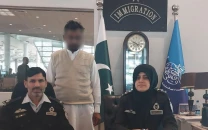Kurram — burying the demons of divide
The Kurram conflict demands modern governance and military intervention, beyond ineffective Jirgas.

Last week we dissected the geo-demographic riddle of Sunni-Shia conflict mainly in the Kurram District with its linkages to parts of Kohat and Orakzai Districts. Some conclusions from the last Op-Ed include: first, the area geography and demography compel the tribes to live side by side in 'enforced' peace as an existential imperative. Doing otherwise leads to perpetual violence. Second, overtime the conflict has morphed into a proxy war between TTP and the local Iran-backed Zainabiyun militants. Third, jirgas and the consequent truces will never hold if history is any guide, without modern governance apparatus. Fourth, the State, especially the provincial government, holds the key. Effective and powerful intercession between the warring tribes is way to go in foreseeable future.
Turkic Turis or Torai of Parachinar area dominate Upper Kurram and to some extent, the neighbouring Orakzai District (by sectarian affiliation rather than genealogy). They mainly follow the Asna-Ashari (Twelver) Shia sect. They have traditionally followed Pashtunwali for being surrounded by major Pashtun tribes like Mangal, Maqbal, Ghilzai, Bangash, Orakzai, Utmanzai Wazirs and Dawar. This Pashtun honour code is an over-arching social framework; however, for social interaction within the tribe, Turis follow their own social code, called the Turizoona. Whereas, in Kurram and Orakzai Districts, Islamzoona, another variant of social conduct among Sunni and Shia tribes is followed. Ostensibly, the collective force of Pashtunwali, Turizoona and Islamzoona should be able to institute and maintain tribal social order, but that is not sadly the case.
The frequent and unpredictable breakdown in the social order points towards three recurring problems: a) the Conflict Resolution Mechanism (CRM) under the cited social/religious codes has been considerably weakened because of the induction of extra local forces (the TTP, and the Zainabyoon proxies), and the comparative weakness of the local elite traditionally; b) the generational gap brings to focus the decreasing awareness about the traditional CRM. Hence, the younger cadre is catapulted into the lead, making the conflict more violent due to their waning allegiance to the cited codes of conduct; and c) the mix of 'confused' official-tribal decision making and enforcement system has drained effectiveness from the State machinery, and officials are endemically looking towards traditional means of conflict prevention and resolution, to evade responsibility for conducting hard bargaining.
Jirgas in the 21st Century can be 'complementary tools' in CRM in our tribal context for some time, but they weaken the modern state. State evolution and consolidation mandate that 'Modern Administration' must be in the driving seat squarely, firmly and effectively. In the presence of modern state apparatus, traditional Jirgas are useful only as local CRM to resolve very confined, small and petty disputes, in addition to being mass mobilisation instruments. We are past the state of tribal-based decision-making in our social and political evolution. Even in the tribal universe, riasat (State) is considered as a formidable 'mother institution'. The decisions of PTM's grand Jirga held recently with so much fanfare and promise in Jamrud, to control militancy in KP and Balochistan, remain understandably unimplemented.
It is ironic to see some senior level Government functionaries clamouring to revert, and actually reverting to the archaic Jirga System in the long 'settled' districts of Northern KP. Jirga today is at best a talk shop, good for venting out, opinion mobilization and 'local' dispute resolution (as cited), but never an alternative to the modern State apparatus, especially in dealing with complex and intractable issues like militancy and sectarian wars. It amounts to going back in time. Administration, especially in the crisis-ridden areas, needs to be careful about their sole reliance on such archaic platforms and tools. It must also be noted that Jirgas are also used by budding local politicians for relevance and political purposes.
Militarily, Kurram presents another enigma. The Shia Turis of Parachinar and Upper Kurram area were threatened from the Sunni Mangal/Maqbal Tribes to the west, residing on either side of the Pak-Afghan border. These Sunni tribes would, in times of sectarian wars, reinforce the Sunni hands. And to protect themselves from the Shia backlash, Mangal/Maqbal used to reduce their route dependence through Shia Parachinar, by going around in the Afghan territory and re-enter Pakistan through Kharlachi crossing, bypassing the entire Shia belt upto Bagan. This is not possible now because of the border fence that has divided the Mangal, Maqbal and to some extent the Zadran tribes. However, this militarily happy situation for the Shia community is compromised by ascendence of Sunni Taliban to power in Afghanistan. The area of influence of 'Khostwal Haqqanis' in Kunar, Nangarhar, Khost, Paktia and Paktika lies just west of this Shia belt. Reportedly, Turis have been approaching Haqqanis for intercession and mediation with Sunni Bangash tribe.
So, following from the above discussion about the geography, demography, sociology and some military dynamics of the area under sectarian strife in Kurram, and given the ever-increasing intensity, intractability, enhanced brutality and the repeated failure of Jirgas as CRM, following options are suggested, which are not exhaustive and need further exploration.
First, the State needs to intercede and effectively sit permanently, and in good strength, between the warring sides in collaboration with local stakeholders. FC and Army presence needs to be enhanced manifolds. Road security, consequently, be enhanced and ensured.
Second, population relocation and provision of different entry/exit routes to such sect-based enclaves. Living together in peace and harmony is only a pipedream. The State can weigh up the option of relocating populations based on sect, with different variations, depending upon the resources available, to provide different, separate and not crisscrossing routes to both communities to avoid provocation and conflict.
We discuss and deliberate on the above two options and other CRMs next week in detail.
Meanwhile, one hopes that the politically amateur, agitational and protest-laced dispensation in KP would find the time and 'permission' to focus on the province's myriad problems, Kurram being one. 'Lament' will lead nowhere. One remembers the Corps Commander visiting the troops, meeting the stakeholders to get a feel of the situation in 2007 on Day 2 of the conflict. Mr Gandapur, rather than persisting with his useless and politically suicidal yalghars against Islamabad, needs to grow up, find time, resources and the courage to face up to the problems and people of Kurram.
They - both sects - are not the children of lesser god!














COMMENTS
Comments are moderated and generally will be posted if they are on-topic and not abusive.
For more information, please see our Comments FAQ